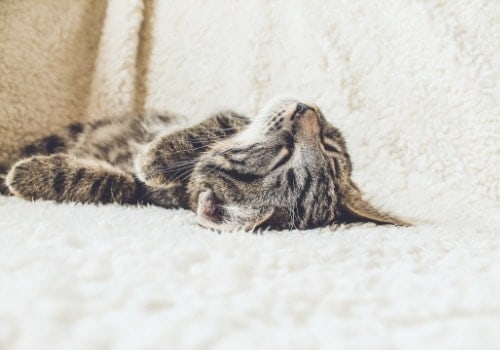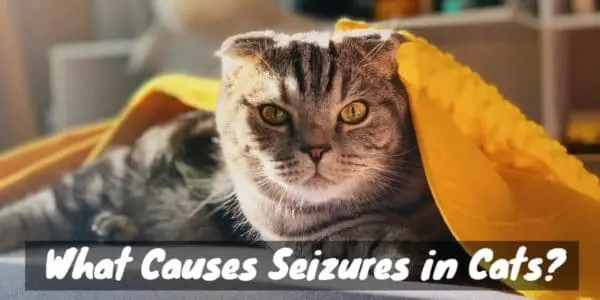A seizure, also known as a fit or convulsion, is defined as uncontrollable muscle activity caused by a temporary disturbance of the brain’s normal function. Epilepsy is defined as a condition in which the cat repeatedly has seizures. A cat with epilepsy may have one seizure at a time or they may have clusters of seizures.
Seizures and epilepsy are both more common in dogs than in cats.
Terminology Relating to Seizures

The pre-itctal phase, which is also sometimes called the “aura,” describes behavioral changes that precede a seizure. Such changes can include head turning, nervousness, or increased attention seeking.
[amazon bestseller=”cats Epilepsy Seizure Formula”]
The post-ictal phase, which can last a day or two, describes the abnormal behavior that follows a seizure. The cat might be agitated, lethargic or depressed. It might also pace or drink or eat more than is normal.
Generalized seizures, or grand mal seizures, are full-blown convulsions. Signs of a convulsion include jerking limbs, rigid muscles, running or paddling motions. The cat may also wet or soil itself, and its head may bend backwards towards the spine.
In status epilepticus, the cat has repeated convulsions that last for over five or ten minutes. Status epilepticus can be life-threatening and should be treated as a medical emergency.
Partial seizures affect only part of the cat’s body. It can take the form of seizures affecting only some muscle groups or behavioral changes like snapping at imaginary objects or chasing their own tail. Partial seizures are rare in cats.
Absence or petit mal seizures are also rare in cats. They are often described as a “brief loss of awareness.”
Causes of seizures are often described as intracranial or extracranial. An intracranial cause is one that affects only the cat’s brain, while an extracranial cause also affects other systems. For example, cats with kidney or liver disease can also have seizures.
Symptomatic seizures are those that have been linked to a structural abnormality within the brain.
Idiopathic seizures, by contrast, have no discernible cause. The cat’s brain is normal, and the cat has no diseases that might cause seizures. Idiopathic seizures are often chalked up to genetic causes.
What Causes a Cat to Have Seizures?
Seizures in cats are most commonly caused by some kind of injury or damage to the cat’s brain. The cat has recovered from the initial injury and seems normal. In some cases, the vet will not find a cause for the seizures. Both types of cats will be diagnosed as having epilepsy, for they have nothing else wrong with them.
Other causes of seizures in cats can include the following:
• Liver disease
• Hypoglycemia
• Kidney disease
• Tumors
• Head injuries
• Certain infections
[amazon bestseller=”cats Seizure Relief”]
Some toxins can also cause seizures. Pyrethin is an example. It’s a chemical often used in shampoos, tick and flea medications, dips, and sprays. It is often used in over-the-counter flea treatments, especially those designed for dogs.
Exposure to pyrethrin can cause a cat to have seizures and muscle tremors.
How Can the Vet Diagnose the Cause of the Seizures
The vet will start by taking a detailed medical history of the affected cat. They may ask questions like the following:
• How old was the cat when it first started having seizures?
• Do the seizures appear to be getting worse or more frequent?
• Has the cat had any medications, like de-worming or flea control drugs?
• Could the cat have been exposed to any poisons?
• Is the cat most likely to have a seizure after waking up, while eating, etc.?
• Does the cat have any other signs of illness like lethargy or poor appetite?
After taking the cat’s medical history, the vet will administer a variety of tests to determine the cause. They will perform blood tests to rule out extracranial causes like liver disease. They will also perform brain imaging exams like an MRI (magnetic resonance imaging) or CT (computer-assisted tomography) to look at the brain’s structure and check for any abnormalities.
Treatment for the seizures will depend on their cause. In many cases, the vet will prescribe an anti-convulsant medication, especially if the cat has more than one seizure every six or eight weeks. The more frequent the seizures, the greater the risk of brain damage and other complications.
What Is a Meningioma?

A meningioma is the most common type of brain tumor in cats, and is found in about 60 percent of patients. It affects the meninges or system of membranes around the central nervous system. It can affect any breed of cat, and it usually affects cats that are at least nine years old.
[amazon bestseller=”organic cat vitamins”]
While the symptoms can vary depending on the location of the tumor, they usually include seizures. Other symptoms can include uncoordinated movements, pain in the neck and/or back, vision problems, and abnormal behavior.
In most cases, the vet will try to remove the tumor. They may also recommend radiation therapy, medications, dietary changes, and/or fluid therapy to treat the cat’s symptoms.
How Does a Stroke Affect Cats?
A stroke is a condition caused by the impairment of a blood vessel’s ability to transport blood to the brain. There are two types of stroke. In a hemmorhagic stroke, a blood vessel bursts and the blood damages nearby brain tissue. In an ischemic stroke, a clot within the blood vessel blocks the blood. If the clot developed within the blood vessel, the cat is said to have a thrombosis. If the clot migrated from another part of the body, the cat is said to have an embolism.
The symptoms that accompany a stroke depend less on the type of stroke and more on the part of the brain affected, the amount of brain tissue involved, and the severity of the stroke.
In addition to seizures, symptoms of a stroke can include the following:
• Walking in circles
• Unequal pupil sizes
• Abnormal eye movements
• Spasms that cause the head and body to arch backwards
• Weakness
• Unsteady walk
• Head tilt
• Coma
Stroke usually affects cats that are at least nine years old. A variety of conditions can increase the risk of cat suffering a stroke. They include heart disease, kidney disease, diabetes, lung disease, liver disease, high blood pressure, cancer, hyperthyroidism, parasitic infestations, and various infections.
[amazon bestseller=”cat treatment”]
What Is Encephalitis?
Encephalitis is an inflammation of the brain, and it can be life-threatening. It is sometimes accompanied by meningitis and/or inflammation of the spinal cord (myelitis). Encephalitis has multiple causes. In some cases, it will be idiopathic or have no discernible cause. In other cases, the vet will find a cause like a bacterial, viral, or fungal infection. Parasitic infestations and disorders of the immune system can also cause encephalitis.
Symptoms of encephalitis can vary depending on the part of the brain affected. In addition to seizures, they can include fever, paralysis of the face, abnormally small pupils of unequal size, and decreased responsiveness and consciousness.
What Is Hydrocephalus?

Hydrocephalus means “water on the brain,” and it describes an abnormal accumulation of fluid within the skull. The resulting pressure on the brain causes seizures, blindness, and abnormal behavior. The affected animal also develops a dome-shaped and enlarged head. Hydrocephalus can also affect dogs and humans.
There are two types of hydrocephalus: primary and secondary. Primary hydrocephalus is congenital and becomes obvious within a few weeks after birth. Secondary hydrocephalus is acquired and can be caused by any injury, tumor, or inflammation that impairs the normal flow of fluids in the brain. The breeds most likely to be affected by primary hydrocephalus include Siamese, Persian, and Manx cats.
What is hepatic encephalopathy
Hepatic encephalopathy describes any disorder of the brain caused by a liver disease. The liver disease can have a variety of causes. The damaged liver isn’t able to process ammonia properly, and the accumulated ammonia gradually affects the brain.
Depending on the cause of the liver disease, hepatic encephalopathy can be congenital or acquired.
In addition to seizures, symptoms of hepatic encephalopathy can include the following:
• Lethargy
• Orange-brown urine
• Lack of urination or abnormally frequent urination
• Producing abnormally small amounts of urine
• Compulsively pressing the head against objects
• Vision loss
• Diarrhea
• Vomiting
• Increased thirst
• Loss of appetite
• Drooling
• Compulsive pacing
• Crying
• Sudden aggression
What Toxins Can Cause Seizures in Cats?

Pyrethrin, unfortunately, isn’t the only chemical that can cause cats to have seizures.
Permethrin, which is sometimes sold under the brand name Nix, is one of the most common causes of seizures in cats. It is a medication and insecticide that is used as a flea treatment for dogs. A cat can be poisoned by it if somebody uses it to treat the cat for fleas, or if the cat has close contact with a dog that has been treated with permethrin.
Bromethalin is a chemical used in rat and mouse poison. It works by attacking the nervous system, and cats are more sensitive to its affects than are dogs.
Minodixil is a medication used by humans to widen blood vessels and stimulate localized hair growth. It is lethal to cats. In addition to seizures, minodixil causes pulmonary edema and severe heart problems.
Alpha lipoic acid is an ingredient in many supplements. Giving a cat too high a dose can cause seizures, hypoglycemia, and liver damage.
Acetaminophen is used to treat fever and pain in humans. It can cause a blood disorder called methemoglobinemia in cats, and it also causes seizures and hypoxia.
Moxidectin and Ivermectin are both anti-parasite drugs used to treat different mammalian species; Ivermectin can be used on humans. Overdoses of both drugs cause seizures, depression, and ataxia in cats.
The comparatively small size of cats apparently makes them susceptible to drug overdoses. Ibuprofen, mirtazapine, and diphenhydramine are all medications that can cause seizures in cats if the vet gives them too much.
Fluoroquinolone antibiotics are yet another type of medication that cause seizures in the event of an overdose. An overdose is especially likely to occur if the vet gives the drug intravenously. The antibiotics apparently work quickly, and some cats will have a seizure even before the vet has finished administering the medication!
[amazon bestseller=”cats detoxing”]
Some people use tea tree oil to treat skin conditions on cats and dogs. It contains chemicals called terpenes that make it an effective antibacterial and antifungal treatment – but are toxic if ingested. Cats can thus be poisoned if they groom themselves after treatment or if the vet or owner uses too strong a concentration.
Baclofen is a medication for humans used to treat muscle spasms. It is extremely toxic to cats and dogs. In addition to seizures, a cat that has ingested baclofen will suffer depression and apnea and go into a coma. Baclofen is powerful and can kill.
"In ancient times cats were worshipped as gods; they have not forgotten this."
-- Terry Pratchett





